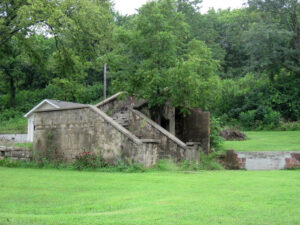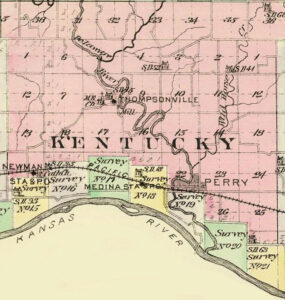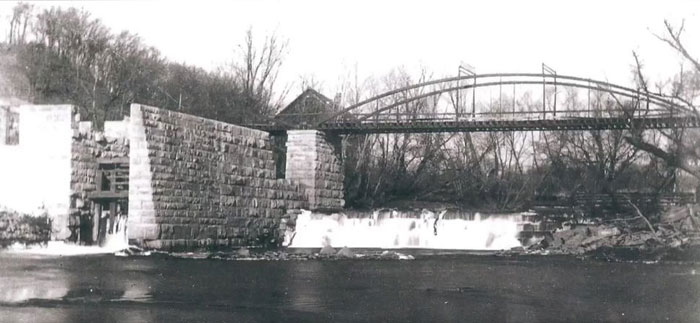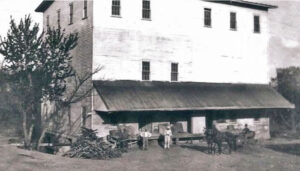Thompsonville, Kansas, was a hamlet located on the Delaware River in Kentucky Township of Jefferson County.
The first Thompsonville mill originated In 1834, twenty years before the territory was established, when an English millwright from Independence, Missouri, was hired by the U. S. Government to build a mill on the Delaware River to grind corn for the Indians. The mill site and log dam were located where the river swung against the point of the bluffs. After some years, that mill fell into disrepair,
In 1851 a few Mormon families en route from Missouri to Salt Lake City, Utah, stopped in Jefferson County, where Thompsonville was located. They initially refused to accompany the main group led by Brigham Young to the Salt Lake Valley. Among those settlers was Emily Trask Cutler Kimball, one of the plural wives of Heber C. Kimball, counselor to Brigham Young, and daughter of John Alpheus Cutler, who founded the Cutlerite sect in Manti, Iowa, while en route with the main body to the Salt Lake Valley.
The Mormons rebuilt the mill, and over the next several years, they made other improvements. Three log cabins were built, and about 15 acres of land were cultivated.
While there is no evidence that the founding group of the settlement had doctrinal differences with the main body of the church, it is possible that they were opposed to the doctrine of polygamy since Emily Trask Cutler Kimball did not accompany the main group. It is equally likely that the group saw no need to go so far west when new frontier lands were open and available in the Kansas Territory and actively recruited new settlers from anti-slavery parts of the country.
Emily Trask Cutler Kimball died of cholera not long after the settlement was established and is buried there. Two other Mormon women named Mrs. Archer, and Mrs. Platt also died of cholera. All three were buried on the edge of the timber, and tombstones were put up with the names cut on them. Until the mid-1960s, the stones could still be seen.
When Kansas became a territory, the border war began, and they found they could not obtain the lands in Kansas they moved on.
In 1856, Solomon Everett, a Delaware Indian, who had been with General John Fremont on his Rocky Mountain expedition, built a sawmill on the Delaware River. Everett’s dam was built of logs. When the Civil War began, the site was abandoned.
In 1868, Charles L. Thompson acquired the mill site, eventually built a stone dam, and refitted the large mill building. It opened for business in 1874 as Thompson’s Mill. The three-story mill building that included a basement measured 40 by 60 feet. A later sawmill just to the north was powered by a cable from the mill wheel.
Soon a settlement was founded around the mill. On June 17, 1878, a post office was established with C. T. Tolles as postmaster. By the early 1880s, the mill was one of the largest and best flouring mills in the county. At that time, Thompsonville had a store, a church, a post office, and a population of about 70.
The mill was enlarged in 1884, and operating night and day, the mill was producing 125 barrels of flour per day and was shipping to all the towns in Jefferson County and Topeka and Lawrence, with wagons drawn by four mules.
On May 31, 1901, the post office closed, after which the mail was supplied from nearby Perry, Kansas.
One wall of the old mill remained until about 1960, when the stones were used for other purposes.
Thompsonville was located three miles northwest of Perry on the Delaware River.
©Kathy Alexander/Legends of Kansas, May 2022.
Also See:

Ruins of an old church in Thompsonville, Kansas, courtesy Kansas Ghost Town Hunter.
Jefferson County Extinct Towns
Jefferson County Photo Gallery
Cutler, William G; History of Kansas; A. T. Andreas, Chicago, IL, 1883.



